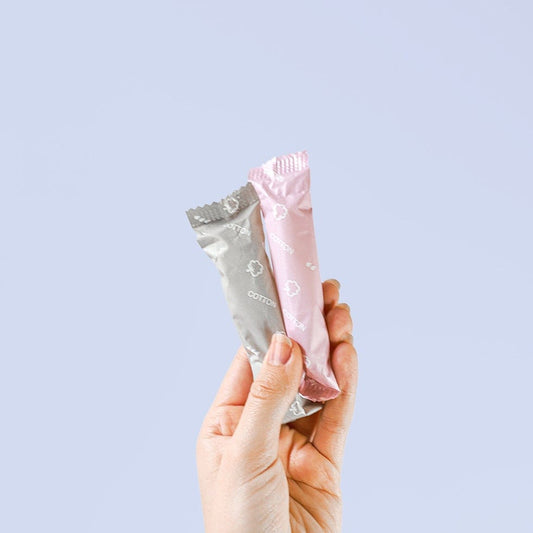How long can you leave your tampon in for? It's a question that many people have, and it's a valid one. After all, you want to make sure you're using them safely and correctly. In this blog post, we'll answer that question for you and give you some other tips on using tampons correctly.
How long a tampon should be in your body
Before we answer this question, our response depends on a few factors.
First, it depends on your flow. If you have a heavy flow, you'll want to change your tampon more frequently than if you have a light flow.
Second, it depends on how often you go to the bathroom. The more frequently you urinate, the more likely it is that your body will expel the tampon and it will need to be changed sooner.
Finally, it depends on the absorbency of the tampon. The more absorbent the tampon, the longer you can leave it in without risk of toxic shock syndrome (TSS). Tampon manufacturers and tampon boxes clearly warn how long their tampons are meant to be kept in the body.
The general maximum recommended time to leave a tampon in is about 8 hours, although, whenever you start to feel discomfort or your tampon feels full before the 8-hour mark, it's time to change it.
Your flow
If you have a heavy flow, you might need to change your tampon more frequently than every eight hours because you could bleed through the tampon you are using.
If you have a light flow and go to the bathroom frequently, you might be able to leave your tampon in for up to twelve hours, although this is not recommended.
Remember, the key is to listen to your body and change your tampon when you feel discomfort, or when it feels full.
Average amount of time to leave a tampon in
On average, a woman changes her tampon every 6 hours and uses about 4 tampons per day.
However, it is important to remember that every woman is different and will have different needs when it comes to changing her tampon. Some women might need to change their tampon more frequently than others because of their flow or how often they go to the bathroom.
What are the risks of leaving a tampon in for too long?
The intention of tampons is to soak up menstrual blood and stop it from flowing out of your vagina, but when you leave a tampon in too long, it can become a breeding ground for microbes. This means that bacteria that naturally live on your skin and in your vagina can overgrow, leading to an infection.
Toxic Shock Syndrome
Leaving a tampon in for too long can lead to toxic shock syndrome (TSS), which is a rare but serious illness. TSS happens when bacteria grow on the tampon that release toxins into your body through the uterus or vaginal lining. This is generally caused by leaving a tampon in the body for too long.
Symptoms of TSS can include:
- High fever
- Vomiting
- Diarrhea
- Muscle aches
- Sunburn-like rash
- Redness of your eyes, mouth, and throat
- Dizziness or fainting
- Low blood pressure
Some people have said that TSS can feel like an allergic reaction at first. When symptoms worsen, seizures and organ damage, or even death can take place.
If you experience any of these symptoms, it's important to remove the tampon and seek medical attention immediately.
Though TSS is very serious illness, remember that it is very rare. It is estimated that 1 in every 100,000 menstruating women get TSS related to the use of a tampon. Most of the time if you leave a tampon in for more than eight hours, you'll just need to remove it and remind yourself to be more careful moving forward.
BV and Yeast Infection
Bacterial Vaginosis and yeast infections are another side effect of keeping a tampon in for too long.
Bacterial Vaginosis is essentially when there is an overgrowth of bacteria in the vagina. This can lead to a number of symptoms like burning, itching, grayish-white discharge, and a fishy odor.
Yeast infections are caused when there is too much yeast in the vagina. When this happens, you might experience itching, burning, redness, and pain during sex.
Both of these infections can be treated with medication. However, it's best to avoid them altogether by changing your tampon every eight hours or less.
Menstrual health
There are a few key things to remember when using tampons:
- Change your tampon every 8 hours or as often as you need to feel comfortable. To stay on the safe side, change it every 6 hours!
- Use caution while sleeping with a tampon. If you sleep longer than 8 hours, opt for a menstrual cup or pad instead of a tampon!
- Never wear a single tampon for more than 8 hours at a time.
- Consult a doctor or health care professional if you have symptoms of TSS. This is a very serious infection that, in rare cases, can lead to death if not dealt with properly.
Other period care options
If you are nervous about using tampons, there are other options for you! You could try an alternative option like a pad, period undies, or menstrual cup.
Need more direction using tampons?
Try reading our blog post How to Insert a Tampon: Step-by-Step Guide for more information on tampons!
We at Garnuu care about women's health and want to keep you as informed as possible! Be kind to your body and change your tampon often! Thanks for reading.
XO,
Garnuu Team









